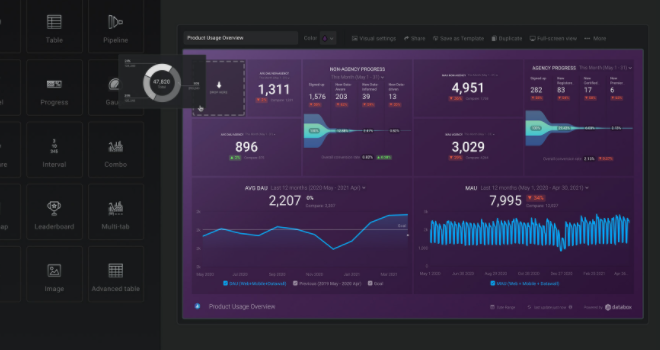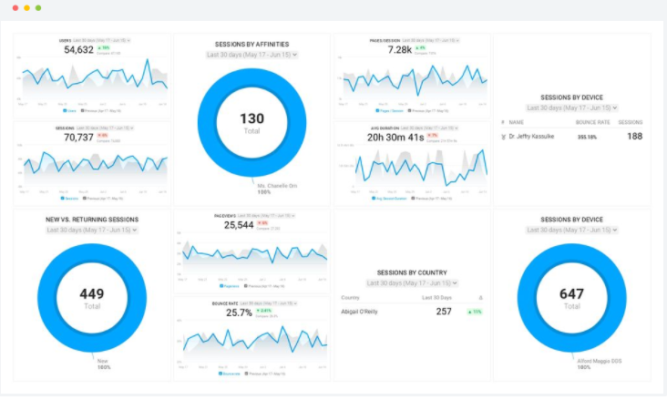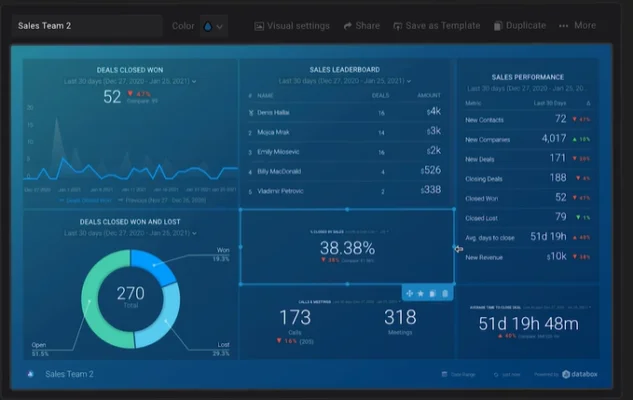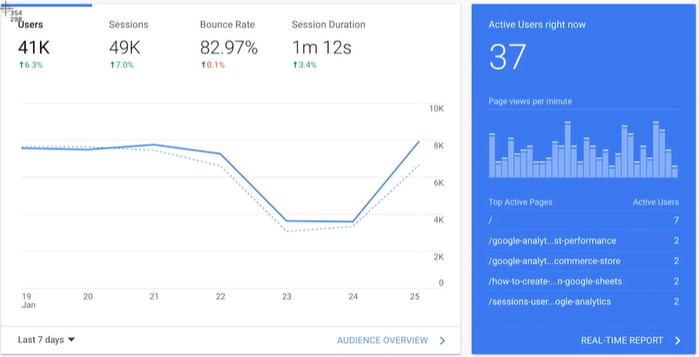What is Databox?
Databox leads the way in the Dashboarding market with powerful data visualization tools, connections, and interactive reports. It helps organizations tell better stories with user-friendly, flexible dashboards.
Databox is a platform to make better decisions by tracking performance and understanding your business. It manages your data and metrics from various sources like cloud services, applications, databases, and spreadsheets.
If you’re into data-driven marketing decisions, Databox is your go-to. It lets you create dashboards, set goals, and receive alerts, recommendations, and important KPIs when needed.
Databox for Google Sheets
Databox is a user-friendly content management system made for Google Sheets. It lets you build and handle your content effortlessly, and you can include custom fields from other platforms like WordPress forms or contact forms.
Databox is designed to help companies create and manage their online presence. Developed by experienced software engineers, it’s made for all kinds of businesses.
What are the goals of using Databox?
- Pull all of our data into one place.
- Build live/interactive dashboards.
- Set and track performance against goals.
- Make data accessible everywhere, on TV or your phone.
What is a Data Board?
A data board is an interactive way to take a data-driven approach to decision making and explore and answer questions in your organization. A data board is a great way to explore and answer questions in your organization by taking a data-driven approach to decision making.
Uses of Data Board in DataBox
A data board is a place for storing notes, pictures, or other information relevant to a project or topic. Data boards are useful in many ways because they are meant to store information about one specific topic. They are often used in classrooms to encourage discussion and ideas between different students. Data boards are also commonly used in offices to provide quick access to the current status of projects.
The Data Board displays data on a series of boards.
The Data Board displays data on a series of boards, with a “programmer” who watches the data and makes sure it is displayed properly. The data board looks like a series of boards stacked on top of each other. For example, the top board displays a single number, which changes as time passes. There are also a few sets of numbers on the next board below, with a programmer watching them and making sure they are displayed properly.
This allows people to see at-a-glance what is happening in the factory
The management of the company is able to monitor production with the use of online monitoring software. This allows people to see at-a-glance what is happening in the factory, making it easier to spot potential problems or quality issues. This system provides an easy way for the company to manage their production. The management can monitor production with the use of online monitoring software. This system provides an easy way for the company to monitor production with the help of online monitoring software.
Talking about using a Monitor to display the Dashboard
The LED displays are easily visible at any distance, and the display is customizable to meet the needs of any company. The LED displays are easily visible at any distance, which means that the displays can be seen from a long way away. They can also be customized to meet the needs of any company.
How to Integrate Databox with Your Google Sheet
Step 1: Connect Google Sheets
Open the Databox web app, and navigate to the Databoard section. Create a new Databoard. The left-hand panel is where you choose the data sources that you want to connect to and combine in this dashboard.
Step 2: Create a custom metric
1. Custom Metric Name
You can enter a name for your metric. Otherwise, skip the rest of this section and continue. A custom metric is a named column or row that you want to track within your spreadsheet. We will add this column or row header and populate it with your custom metrics whenever you choose one of the values within that spreadsheet.
2. Value (Metric)
The first step is to select a column, row, or cell range that hold the numerical values you want to visualize. Next, highlight the cell and press the down arrow key until it moves to the bottom of the worksheet. Press Enter to enter that value. Then make a second selection directly on the spreadsheet by highlighting the cells with your mouse.
‘A1’ is the cell range where the information is stored. If you want to change it, you need to use the ‘A1 notation’ – e.g., A1 = ‘B2’ means that the cell range B2 contains the cell with the text “change. You should always make sure that your values are numerical values, not strings.
3. Date (Timestamp)
The next step is to choose a column, row, or cell range with dates (timestamps). The input selections shown in the example below are made using the Databox Query Builder. To select a range of cells directly on the spreadsheet, highlight the cells you want to visualize and then click the Select Row (or columns) icon. Don’t select a different range of cells. The corresponding cells must have similar values to use a formula like that. The ‘Date’ or ‘Date time’ can be any formatted number or date (in any format).
Dimensions are optional, and you can reference other data points in your spreadsheet if you wish. Custom metrics allow you to view multiple dimensions of data at once. To visualize multiple dimensions, you must create another custom metric.
Step 3: Drag and drop your custom metric onto a Databoard
Now that your query is saved and you’ve made your first metric, you can easily drag and drop it right into your dashboard.
What are the Benefits of Databox?
Databox is a user-friendly web-based dashboard that gives you instant access to your website’s data and analytics metrics in real-time, with no need to download files or plugins. It offers a unified view of your website’s metrics across multiple locations and devices, allowing you to create, edit, and manage content effortlessly.
Here are the benefits of Databox marketing metrics:
- Instant Access: Get real-time access to your website’s data and analytics metrics without any downloads or plugins.
- Unified Dashboard: View all your website metrics in one place, across various locations and devices.
- Easy Management: Effortlessly create, edit, and manage content with a user-friendly interface.
- Time and Cost Savings: Mastering Databox can save you significant time and money.
- Quick Information Retrieval: Easily digestible format allows you to get the information you need within seconds.
- Effective Communication: Customizable dashboards are perfect for presenting to stakeholders, proving the value of the marketing department.
- Alignment of Efforts: Align all departments and systems to achieve your marketing goals effectively.
How Can Databox Help Your Business?
Consistent User Interface
Databox can connect with data sources such as HubSpot, Google Analytics, Facebook, Twitter, Instagram, and more. As a result, businesses no longer have to track the various UI’s associated with these data sources. Instead, they can just focus on the Databox platform.
Less Time Report Building, More Time Analyzing
Once all the data sources are connected to Databox and the dashboards are personalized as needed, your work is done. Say goodbye to excel spreadsheets and databases! You can now spend more time analyzing the results of the data rather than constantly trying to build up-to-date reports.
Data-Driven Decision Making
Real-time reporting allows for the ability always to have current analytics. In addition, the dashboards automatically update every hour, which gives users the capability to be more data-driven in decision making rather than waiting for monthly reports to decide the next plan of attack.
Transparency
Businesses can feel confident knowing they can effortlessly view easy-to-understand dashboards on a computer or the go. Databox also encourages users to set goals and performance notifications. This makes it easier to view online marketing performance and adjust more quickly than with monthly static reports.
Smart Goal Tracking
Databox has added the ability to set, revise, and assign tracks Specific, Measurable, Assignable, Realistic, Time-bound (SMART) goals and track performance automatically and all-in-one-place using performance data from 60+ tools.
What are some of the advantages of using DataBox?
Pull together data from various sources to get a full picture of your business performance. This makes it easier to see what’s working and what isn’t, so you can make course corrections when necessary.
Your business needs to have one central source of truth. Everyone is viewing the same information, which increases visibility for the business and collaboration across departments.
- Control Data Access: Control Data Access allows different roles within an organization to access dashboards in the same way they do in Control Data’s other products.
- Identify Trends: Visualizing performance enables users to identify different trends and draw correlations between two or more metrics.
- Create Targeted Campaigns: Segment and view audiences according to different criteria such as geographic locations or the amount of traffic they generate. This enables the creation of targeted campaigns.
How to Use Data from Databox Reports?
Your boards are all built, so it’s time for the final step—the report creation tool. This tool creates reports that visually appeal to prospects, give them an up-to-date snapshot of their sales performance, and automatically update those reports as soon as they’re submitted. Your sales are currently going well. You’ve got an excellent handle on where you’re at with your business. Use this opportunity to make strategic adjustments to your goals, KPIs, and tactics so you can continue to grow.
Vanity metrics, the ones that seem like they’re easy to create, are often just that, cheap tricks to drive the sales process. They are not valuable insights and can cause you to waste time and money. Instead, as an online retailer, you want to analyze the metrics that measure your performance, and determine which are most important for your business, and then set goals to help you improve on those metrics.
You’re likely not going to see all of the information you need in one dashboard. As a result, we typically create multiple dashboards for our clients. We’ve found that the best dashboard displays a handful of the highest level KPIs along with a few key tactical and tactical inbound marketing assessments. In addition to the Databoard tool itself, we use Databoard for the following purposes: a high-level website analytics dashboard, blog performance metrics, and SEO monitoring.
What are the Key Features of Databox?
Organising and visualising data has never been easier! Data visualisation can be done in various ways, but all of them require a bit of practice. Data with pre-configured visualisations, like lines, heatmaps, pie charts, tables, number blocks, gauges and graphs. However, creating your own visualisation can be very daunting. Pick from different time intervals to compare performance, add trend lines and averages.
Pull data from multiple sources and drag-and-drop to quickly visualize key performance indicators (KPIs) in a dashboard. You can resize, delete, or move data blocks with ease while encompassing blocks are resized to make room. Dashboards are optimised to fit any screen.
Query Builder
Build custom metrics with an array of different dimensions and filters to get an in-depth view of company data. It includes a UI-based interface that will help you build and save custom queries and reports. You can pull and compare historical data and get a segmented view of specific performances without having to learn any query languages.
Data Calculations
It adds, subtracts, multiplies, and divides data from multiple sources to calculate ROI, conversion rates, return on ad spend, customer acquisition cost and numerous other metrics with its built-in calculator. In addition, in the Associate’s Dashboard, you can view your Amazon Associate account details, including the number of products sold, commissions, earnings, and more.
The goal-setting methodology of PPP will make you focus on achieving your goals. It will also clearly understand what goals are important to you and what metrics you need to measure to achieve those goals.
White Labeling
White Labeling your own reports and dashboards is an opportunity to get your brand in front of your clients. White Labeling is also called application wrapping or application virtualisation. For example, a web or mobile app can be wrapped to be deployed on an Android phone.
Scorecards and Alerts of Databox
Scorecards and Alerts are great features for getting instant insight into your business and making data-driven decisions that will help grow it. For example, the more goals you meet or your business meets its goals, the more money you will make. You’ll receive notifications when goals are not being met so you can take immediate action to bring goals back on track and increase revenues. In addition, this is a great way to get alerted on other related metrics.
Databox Annotations
Give context to metrics by adding thoughts and observations as texts or images directly into dashboards. Any team can use tools to respond to and interact with other users to increase collaboration.
It’s a little like a notification-type feed that’s reverse chronological on the left side of the screen and is a kind of live data visualization for Facebook. It’s like an Amazon feed for Facebook, but for news.
Looped Dashboards of Databox
Looped Dashboards are a new feature in Power BI that lets you easily create custom dashboards for viewing and exploring data insight by sliding through them on either a computer or TV screen.
Measure Your Marketing Success with Databox
You’re already on the right path to building your own online business. Now, you can take the next step toward growing your online business. Databox can help you streamline the process of setting up your business to improve the efficiency and success of your business.
If you want to learn more about how Databox can help your business, we recommend connecting with Ubique Digital Solutions. UDS is a Databox Premium Partner and uses this tool to integrate applications and important processes in your digital business. Contact us today.
FAQs
Q: How to troubleshoot viewing all Facebook Pages when connecting Facebook to Databox?
Connect Facebook to your Databox account to view your pages. To do this: Log in to the Databox site, click the “Facebook” tab on the left side of the screen, and enter your Facebook credentials.
Q: What Facebook permissions do you need to connect to Databox?
To connect a Facebook Page to your Databox, the user must have Admin, Editor, or Moderator Page Role set up for the Facebook Page.
Q: How can Databox help your Facebook Metrics?
Databox can boost your Facebook Metrics by helping you track how many people view your Page or follow you on Twitter. You can set specific timeframes to analyze data once you’ve added a new metric to your Facebook Page. It collects and analyzes detailed data on customer behavior and usage, empowering you to make informed business decisions.











